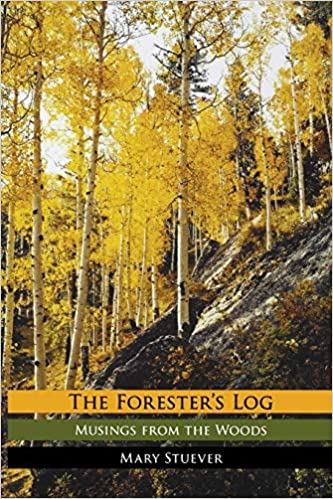
I frequently browse the books at the Little Free Library closest to my house in hopes that I’ll find something good. Romance and crime novels often fill the two small shelves. And sometimes pamphlets on Jesus or PETA. There’s been an Anne McCaffrey book in there for months now that always catches my eye, except it’s the second book in a series. I keep looking anyway because once in a while, there is a real gem. (Also, knowing that I’m unlikely to find anything I want actually makes it feel safer to look because I’m not worried about coming home with a giant pile of books.)
The Forester’s Log by Mary Stuever (Amazon affiliate link) was one of these occasional gems. Mary Stuever spent here career as a forester, working mostly in the southwest United States. During this time she wrote a column called The Forester’s Log which was published in a number of newspapers. The book is largely a collection of some of these writings with a few of her other articles added in.
There are five main sections including fire, forestry, burn area recovery, environmental education and recreation. Each section contains several articles. The articles are from 1985 to 2008. The articles are often aimed at enlightening the general public on forestry practices and issues.
What I love about it
The locations covered
This book covers a lot about locations that I am familiar with, particularly in New Mexico. One of the fires mentioned even happened in my neighborhood (long before I lived here) so it hits close to home. I love books about places I’m familiar with although I also get very into books that let me feel like I am learning about totally different places too.
There is also a part in the recreation section about Stuever’s attempt to climb Pico de Orizaba in Mexico. I climbed it when I was 13 so again it was fun to be intimately familiar with the setting.
The importance and relevancy of the topic
The writing about forest management, forest fires and burn area recovery seemed particularly relevant today as there are so many wildfires across the world. The problems Stuever writes about have only grown exponentially more pressing.
The section on burn area recovery includes a lot about the work after the 2002 Rodeo-Chediski fire in Arizona. According to Wikipedia, this was Arizona’s worst recorded fire… until 2011. As we see record-breaking fires each year, I think it’s really important to think about how this land is rehabilitated afterward. There are huge issues post-fire like soil erosion and flash flooding that we see repeatedly in burned areas.
After reading this, I strongly believe that burn area recovery needs to become a much more talked about (and funded) piece of the climate-change fight.
This book also makes clear the increasing urgency of better forest management. After decades of fire suppression our forests are so filled with excessive fuels that when fires do burn, they burn hotter, longer and further than 100 years ago.
It’s clear to me that doing something about this problem needs to be a much higher priority in our country. Sadly, with so many of our forestry professionals spending more and more time on active fires there will be even less time for them to focus on fire prevention.
Overall, I learned many things about forestry and burn area recovery.
What I don’t love
The book is a collection of articles originally intended to be able to stand on their own. There are several articles that contain redundant information which is just a little obnoxious when reading the book straight through.
At times the author’s sense of humor and wit really show through and at other times the reading can be a bit flat. It’s definitely more of a book to read to learn about the issues than something to read purely for entertainment. (It did still have some moments of entertainment though.)
I also would enjoy a book that just dug a little deeper into some of the topics. Something that allowed me to geek out on forest management a bit more. Although that may not be a fair critique since that’s not really what this book is trying to be.
Who might love this book
I’d definitely recommend this book to anybody who cares about the forest or is interested in learning about wildfire issues.
Actually, I think it would be a relevant book for just about anybody. As smoke from forest fires is spreading across the country and globe, we are ALL impacted by these issues. Even people that don’t live in or near forests are impacted. At the end of the day, healthy forests are part of a healthy planet. That is something we should all care about.
Also I wish all of our government officials in Washington would read it. Maybe I can mail a copy to the president.

